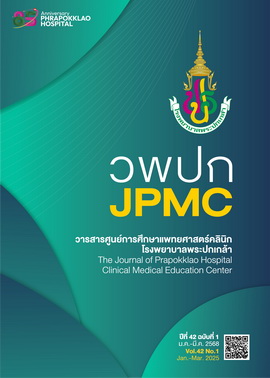ปัจจัยที่มีผลต่อประสิทธิภาพการเรียนแบบ Flipped Classroom ในมุมมองของนักศึกษาแพทย์
Main Article Content
บทคัดย่อ
ที่มาของปัญหา: การเรียนการสอนแบบ Flipped classroom มีวัตถุประสงค์เพื่อส่งเสริมให้นักเรียนเกิดการเรียนรู้ด้วยตนเองและเป็นการเรียนแบบ Active learning อย่างไรก็ตามยังไม่มีการศึกษาใดที่อธิบายถึงปัจจัยที่มีผลต่อประสิทธิภาพของการเรียนแบบ Flipped classroom ในมุมมองของนักศึกษาแพทย์ อันจะเป็นประโยชน์ในการเป็นหลักการสำหรับวางแผนจัดการเรียนการสอนแบบ Flipped classroom ในอนาคต
วัตถุประสงค์: ศึกษาปัจจัยที่มีผลต่อประสิทธิภาพของการเรียนแบบ Flipped classroom ในมุมมองของนักศึกษาแพทย์ อันจะเป็นประโยชน์ในการเป็นหลักการสำหรับวางแผนจัดการเรียนการสอนแบบ Flipped classroom ในอนาคต
วิธีการศึกษา: งานวิจัยนี้เป็น Mixed method (retrospective descriptive study ร่วมกับ focus group interview) ซึ่งเป็นการวิจัยเชิงปริมาณ (quantitative study) ร่วมกับการวิจัยเชิงคุณภาพ (qualitative study) โดยการศึกษาแบบสอบถามหลังการเรียนการสอนแบบ Flipped classroom ของนักศึกษาแพทย์ชั้นปีที่ 5 รายวิชาศัลยกรรม ปีการศึกษา 2566 จำนวน 33 คน ของศูนย์แพทยศาสตรศึกษาชั้นคลินิกโรงพยาบาลพระปกเกล้า และการทำ Focus group interview ร่วมกับการวิเคราะห์ข้อมูลเชิงคุณภาพด้วยวิธีวิเคราะห์แบบอุปนัยเพื่อหาปัจจัยที่นักศึกษาแพทย์คิดว่ามีผลต่อประสิทธิภาพในการเรียนแบบ Flipped classroom
ผลการศึกษา: ปัจจัยที่นักศึกษาแพทย์คิดว่ามีผลต่อความสำเร็จในการเรียนการสอนแบบ Flipped classroom สามารถสรุปออกมาเป็น 5 ปัจจัย (STARS) คือ S: study guide หรือเอกสารประกอบการสอนที่มีคุณภาพ T: time คือ ระยะเวลาที่นักศึกษาต้องใช้ในการเรียนรู้ด้วยตนเองไม่ควรเกิน 1- 2 ชั่วโมง และช่วงเวลาที่จัดการเรียนการสอนแบบ Flipped classroom ไม่ควรใกล้กับช่วงสอบลงกอง A: active classroom คือ การเรียนแบบเน้นผู้เรียนเป็นศูนย์กลาง มีกิจกรรมให้นักศึกษามีส่วนร่วมในชั้นเรียน R: reflection คือ การให้นักศึกษาได้สะท้อนความคิดว่าได้เรียนรู้หรือได้ประโยชน์อะไรจากการเรียนบ้าง S: summary คือ การสรุปเนื้อหาโดยอาจารย์ผู้สอนอีกครั้ง
สรุป: การเรียนการสอนแบบ Flipped classroom มีประโยชน์มากในมุมมองของนักศึกษาแพทย์ โดย 5 ปัจจัยที่สำคัญต่อประสิทธิภาพในการเรียน คือ Study guide, Time, Active classroom, Reflection, Summary (STARS) ถือเป็นสิ่งสำคัญที่หากผู้สอนนำหลักการดังกล่าวมาประยุกต์ใช้ในการเตรียมบทเรียนก็จะช่วยให้การสอนแบบ Flipped classroom เกิดประสิทธิภาพสูงสุดในมุมมองของนักศึกษาแพทย์
Article Details

This work is licensed under a Creative Commons Attribution-NonCommercial-NoDerivatives 4.0 International License.
References
Freeman S, Eddy SL, McDonough M, Smith MK, Okoroafor N, Jordt H, et al. Active learning increases student performance in science, engineering, and mathematics. Proc Natl Acad Sci USA 2014;111:8410-5.
Mundy J. The propensity of students to undertake homework in the absence of formal rewards: a teaching note. Accounting Education 2012;21:529-37.
Mehta NB, Hull AL, Young JB, Stoller JK. Just imagine: new paradigms for medical education. Acad Med 2013;88:1418-23.
Davies RS, Dean DL, Ball N. Flipping the classroom and instructional technology integration in a college-level information systems spreadsheet course. Educational Technology Research and Development 2013;61:563-80.
Strelan P, Osborn A, Palmer E. Student satisfaction with courses and instructors in a flipped classroom: a meta-analysis. Journal of Computer Assisted Learning 2020; 36:295–314.
Wiggins BL, Eddy SL, Wener-Fligner L, Freisem K, Grunspan DZ, Theobald EJ, et al. ASPECT: a survey to assess student perspective of engagement in an active-learning classroom. CBE Life Sci Educ [Internet]. 2017 [cited 2024 Nov 1];16(2):ar32. Available from: https://pmc.ncbi.nlm.nih.gov/articles/PMC5459250/pdf/ar32.pdf
Ağirman Nesibe, Ercoşkun MH. History of the flipped classroom model and uses of the flipped classroom concept. International Journal of Curriculum and Instructional Studies 2022;12:71–88.
Pablo-Lerchundi I, Núñez-Del-Río C, Jiménez-Rivero A, Sastre-Merino S, Míguez-Souto A, Martín-Núñez JL. Factors affecting students' perception of flipped learning over time in a teacher training program. Heliyon [Internet]. 2023 [cited 2024 Nov 1];9(11):e21318. Available from: https://pmc.ncbi.nlm.nih.gov/articles/PMC10660000/pdf/main.pdf
Hew KF, Lo CK. Flipped classroom improves student learning in health professions education: a meta-analysis. BMC Med Educ [Internet]. 2018 [cited 2024 Nov 5];18(1):38. Available from: https://pmc.ncbi.nlm.nih.gov/articles/PMC5855972/pdf/12909_2018_Article_1144.pdf
Chen KS, Monrouxe L, Lu YH, Jenq CC, Chang YJ, Chang YC, et al. Academic outcomes of flipped classroom learning: a meta analysis. Med Educ 2018;52:910-24.
Oudbier J, Spaai G, Timmermans K, Boerboom T. Enhancing the effectiveness of flipped classroom in health science education: a state-of-the-art review. BMC Med Educ [Internet]. 2022 [cited 2024 Nov 5];22(1):34. Available from: https://pmc.ncbi.nlm.nih.gov/articles/PMC8753844/pdf/12909_2021_Article_3052.pdf
Singh K, Mahajan R, Gupta P, Singh T. Flipped classroom: a concept for engaging medical students in learning. Indian Pediatr 2018;55:507-12.
Hung HT. Flipping the classroom for English language learners to foster active learning. Computer Assisted Language Learning 2015;28:81–96.
Mason GS, Shuman TR, Cook KE. Comparing the effectiveness of an inverted classroom to a traditional classroom in an upper-division engineering course. IEEE transactions on education 2013;56:430–5.
Kim MK, Kim SM, Khera O, Getman J. The experience of three flipped classrooms in an urban university: an exploration of design principles. The Internet and Higher Education 2014;22:37–50.
James AJ, Chin CKH, Williams BR. Using the flipped classroom to improve student engagement and to prepare graduates to meet maritime industry requirements: a focus on maritime education. WMU Journal of Maritime Affairs 2014;13:331–43.
